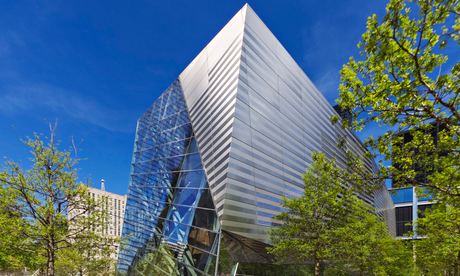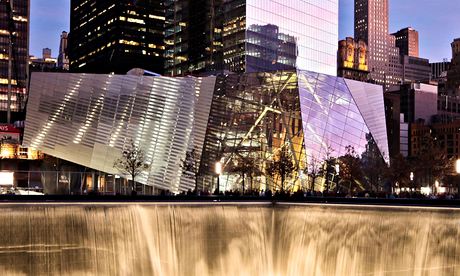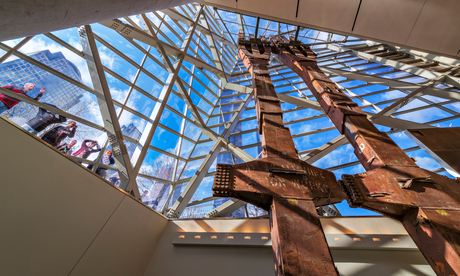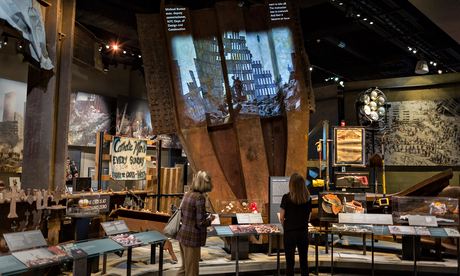9/11 Memorial Museum: an emotional underworld beneath Ground Zero
Scorched
car doors, salvaged firefighters' uniforms, banners, toys and the
hallowed 'last column' to be removed from the World Trade Center
clearance ... the relics of the twin towers have been elevated into art
objects at the new museum, which opens this month after years of
wrangling
• Echoes of atrocity: the 9/11 Memorial Museum – in pictures
• Take a first look inside the museum on our video tour
• Echoes of atrocity: the 9/11 Memorial Museum – in pictures
• Take a first look inside the museum on our video tour


Rising up like an apparition ... Snøhetta's 9/11 Memorial Museum on the World Trade Center site. Photograph: Jeff Goldberg/Esto
In the middle of the World Trade Center site in New York,
tourists squeeze their bodies against the faceted mirror-glass planes
of the 9/11 Memorial Museum, eager to sneak a peek at what lies within.
Rising up like an apparition behind the reflective glazing, beyond the
greasy smears left by noses and sticky fingers, stand two rusted,
fire-charred columns, relics salvaged from the wreckage of the twin
towers.
"It's proving a popular place for selfies," says the architect Craig Dykers, watching visitors capture their reflected faces melding with the scorched structures inside. "If we can get someone to smile or have a giggle at a place of such sorrow," he adds, "we've done our job."
Almost 13 years since the atrocities of 9/11, when nearly 3,000 people were killed in a horrific moment of televised terrorism, the hallowed site of Ground Zero remains as much a place of spectacle as ever. More than 12 million people have visited since the memorial plaza opened in September 2011, to gawp into the voids of the towers' footprints, where endless sheets of water now spill in magisterial cascades into sunken reflecting pools.
Surrounded by a grove of 400 oak trees, interspersed with little slivers of lawn, these cubic waterfalls are breathtaking in their vastness, compressing the power of Niagara into stately dark squares. They have a silencing effect, which is just as well given the surrounding din of construction, where a ring of office towers is slowly rising to replace the 10m sq ft of commercial space that once stood on the site.
Finally opening to the public on 21 May, the museum completes the $700m (£415m) undertaking of the 9/11 memorial project, leading visitors on an Orphean descent to the very bedrock below this most charged of sites. With its faceted flanks shimmering above the trees, the portal to this emotional underworld – designed by Dykers' practice, the Norwegian firm Snøhetta – stands as an angular wedge, thrust into the north-east corner of the plaza. A folded shell of metal and glass, inscribed with horizontal pinstripes along its length, the building has ghostly echoes of a tumbling twin tower, a fallen silvery shaft lying kinked and twisted between the pools.
With its angular form looming imposingly into view, it is one of the few remnants of the visual language conjured by Daniel Libeskind in his original masterplan for the site in 2003, which imagined a circle of fragmented towers rising in a spiral up to a great fractured spire. His proposals were drenched with symbolism, from the spire's summit of 1,776 ft, in honour of the year of American independence, to a chink of light that would fall across the site at the same time on September 11 every year. His pitch won the nation's hearts, but not that of the site's leaseholder, Larry Silverstein, who had already hired his own architects and had other plans.
 Snøhetta's building has ghostly echoes of a tumbling twin tower.
Since then, commercial realities have seen Libeskind's crystalline
rock formation, which looked like something from the planet Krypton,
translated into a more corporate affair of office blocks by a handful of
Pritzker-prize winning architects, including Lords Foster and Rogers.
Now half-finished, it might have been designed as a vertical exhibition
of different curtain wall cladding systems. Libeskind's own jagged spear
of a tower, meanwhile, has become a stumpy obelisk by the global giant SOM.
Snøhetta's building has ghostly echoes of a tumbling twin tower.
Since then, commercial realities have seen Libeskind's crystalline
rock formation, which looked like something from the planet Krypton,
translated into a more corporate affair of office blocks by a handful of
Pritzker-prize winning architects, including Lords Foster and Rogers.
Now half-finished, it might have been designed as a vertical exhibition
of different curtain wall cladding systems. Libeskind's own jagged spear
of a tower, meanwhile, has become a stumpy obelisk by the global giant SOM.
As if to make up for these generic, if well-detailed, slabs of commerce, the terrain below has been given over to a competing frenzy of form-making, with a series of enthusiastically sculpted structures scattered across the site, all trying to embody hope and anguish, optimism and loss, hurt and healing. There are the soaring vertebrae of Santiago Calatrava's $4bn transit hub, still under construction, channelling the wings of a dove and a dinosaur's rib cage; there are the solemn cascading voids; there might one day be a Frank Gehry-designed performing arts centre; and then, nestling among all this, there is the museum pavilion – along with a motley debris of security sheds and ventilation shafts.
In the hands of Snøhetta, the museum building has become Libeskind-lite, his trademark aesthetic of trauma and tragedy filtered though a benign Scandinavian lens. "We wanted to stay true to the feeling of the masterplan," says Dykers, "but the building shouldn't feel too shocking." Within, it is all blond wood and warm, natural tones "to engender a sense of calm, a moment of relaxation before you have to be challenged". Housing an auditorium and a small room for families of the victims, it is well crafted, but has the neutral, rather placid feeling of an airport lounge.
 Two columns (known as 'tridents') salvaged from the twin towers
wreckage form the centrepiece of the Museum pavilion. Photograph: Jeff
Goldberg/Esto
A victim of the legal and political wranglings that have plagued this 16-acre swath of lower Manhattan since 2001,
Snøhetta's building has been slashed to a tenth of its planned size,
when it was once to hold a museum of human rights and a visual arts
centre. It is now essentially a glorified entrance lobby and mechanical
service shed for what lies deep below, the memorial museum proper by the
businesslike US firm Davis Brody Bond. "A traditional museum is an icon
containing exhibits," says partner Steven Davis, as we process down a
snaking staircase from Snøhetta's light-flooded crystal into the
ethereal gloom, passing the gnarled base of the two towering columns.
"But here the exhibits themselves are the icons."
Two columns (known as 'tridents') salvaged from the twin towers
wreckage form the centrepiece of the Museum pavilion. Photograph: Jeff
Goldberg/Esto
A victim of the legal and political wranglings that have plagued this 16-acre swath of lower Manhattan since 2001,
Snøhetta's building has been slashed to a tenth of its planned size,
when it was once to hold a museum of human rights and a visual arts
centre. It is now essentially a glorified entrance lobby and mechanical
service shed for what lies deep below, the memorial museum proper by the
businesslike US firm Davis Brody Bond. "A traditional museum is an icon
containing exhibits," says partner Steven Davis, as we process down a
snaking staircase from Snøhetta's light-flooded crystal into the
ethereal gloom, passing the gnarled base of the two towering columns.
"But here the exhibits themselves are the icons."
With a clearly defined space beneath the plaza, hemmed in by rail lines, services and the exposed concrete slurry wall of the original World Trade Center development, the architects have used a long, looping ramp to take visitors on a "meaningful descent" 20 metres below the surface. The route is framed by the two great cubic volumes of the memorial fountains, which plunge down through the ceiling, wrapped in a textured aluminium skin, like spectral cadavers of the twin towers, beneath which is housed the chief content of the exhibition.
Walking along this dark timber route – which is designed to recall the 200 metre construction ramp by which debris was removed from the site – we pass further steel columns, twisted into monstrous claws by the impact of the planes, and a vast chunk of the transmission mast, spilling out its twisted entrails. Everywhere you look there are steel plates of immense thickness, effortlessly curled like pencil shavings, peeled back like the discarded skin of a banana. Raised on plinths or mounted on the walls and dramatically spotlit, these gut-wrenching fragments are treated like Richard Serra sculptures, elevated into art objects with ghoulish glee, in a way that's not entirely easy to stomach.
It is a form of fetishised architectural salvage that makes more sense when it is cleverly stitched into the visitors' route – where, for example, a set of eroded concrete stairs, down which many of the survivors fled to safety, is placed alongside the staircase down which you must walk. At the bedrock level there are also some powerfully understated moves, such as exposing the column foundations that march in a mute line around the perimeter where the towers once stood, marking the threshold between the cavernous, looser lobby area and the sanctified space of the exhibition within.
 Inside the museum, items on display are taken from the 10,000-strong
collection of objects salvaged from the site: a crushed fire engine and
a charred firefighter's axe, salvaged uniforms, flags and toys.
Photograph: 911 Museum
The exhibition halls were not complete at the time of visiting, but
appear to be densely packed warrens of ephemera, taken from the
10,000-strong collection of objects salvaged from the site: the charred
remains of a firefighter's axe alongside scorched car doors, salvaged
uniforms, shoes and hats, flags and toys, posters and banners of
encouragement from the nine-month site clearance – all towered over by
the hallowed "last column" to be removed from the site, a tattooed totem
pole of hopes and memorials. Audio and video of personal recollections
is mixed with contemporary reporting, building what the exhibition
designers describe as "a multiplicity of subjectivities" through which
the visitor is encouraged to navigate – it being deemed too soon for a
definitive narrative of events to be appropriate.
Inside the museum, items on display are taken from the 10,000-strong
collection of objects salvaged from the site: a crushed fire engine and
a charred firefighter's axe, salvaged uniforms, flags and toys.
Photograph: 911 Museum
The exhibition halls were not complete at the time of visiting, but
appear to be densely packed warrens of ephemera, taken from the
10,000-strong collection of objects salvaged from the site: the charred
remains of a firefighter's axe alongside scorched car doors, salvaged
uniforms, shoes and hats, flags and toys, posters and banners of
encouragement from the nine-month site clearance – all towered over by
the hallowed "last column" to be removed from the site, a tattooed totem
pole of hopes and memorials. Audio and video of personal recollections
is mixed with contemporary reporting, building what the exhibition
designers describe as "a multiplicity of subjectivities" through which
the visitor is encouraged to navigate – it being deemed too soon for a
definitive narrative of events to be appropriate.
It is, in many ways, an apt metaphor for the situation above ground. Every building bears the scars of not only the emotional trauma that is so engraved into these few city blocks, but of the battles that have been fought since 11 September 2001 to agree on anything being built at all. An untold amount of passion, energy and care has gone into the creation of every single piece of the 9/11 memorial museum complex – but these faceted forms are buffeted not just by the anguish and loss of that day, but by the compromise of competing interests that have waged war across the site ever since.
"It's proving a popular place for selfies," says the architect Craig Dykers, watching visitors capture their reflected faces melding with the scorched structures inside. "If we can get someone to smile or have a giggle at a place of such sorrow," he adds, "we've done our job."
Almost 13 years since the atrocities of 9/11, when nearly 3,000 people were killed in a horrific moment of televised terrorism, the hallowed site of Ground Zero remains as much a place of spectacle as ever. More than 12 million people have visited since the memorial plaza opened in September 2011, to gawp into the voids of the towers' footprints, where endless sheets of water now spill in magisterial cascades into sunken reflecting pools.
Surrounded by a grove of 400 oak trees, interspersed with little slivers of lawn, these cubic waterfalls are breathtaking in their vastness, compressing the power of Niagara into stately dark squares. They have a silencing effect, which is just as well given the surrounding din of construction, where a ring of office towers is slowly rising to replace the 10m sq ft of commercial space that once stood on the site.
Finally opening to the public on 21 May, the museum completes the $700m (£415m) undertaking of the 9/11 memorial project, leading visitors on an Orphean descent to the very bedrock below this most charged of sites. With its faceted flanks shimmering above the trees, the portal to this emotional underworld – designed by Dykers' practice, the Norwegian firm Snøhetta – stands as an angular wedge, thrust into the north-east corner of the plaza. A folded shell of metal and glass, inscribed with horizontal pinstripes along its length, the building has ghostly echoes of a tumbling twin tower, a fallen silvery shaft lying kinked and twisted between the pools.
With its angular form looming imposingly into view, it is one of the few remnants of the visual language conjured by Daniel Libeskind in his original masterplan for the site in 2003, which imagined a circle of fragmented towers rising in a spiral up to a great fractured spire. His proposals were drenched with symbolism, from the spire's summit of 1,776 ft, in honour of the year of American independence, to a chink of light that would fall across the site at the same time on September 11 every year. His pitch won the nation's hearts, but not that of the site's leaseholder, Larry Silverstein, who had already hired his own architects and had other plans.
 Snøhetta's building has ghostly echoes of a tumbling twin tower.
Since then, commercial realities have seen Libeskind's crystalline
rock formation, which looked like something from the planet Krypton,
translated into a more corporate affair of office blocks by a handful of
Pritzker-prize winning architects, including Lords Foster and Rogers.
Now half-finished, it might have been designed as a vertical exhibition
of different curtain wall cladding systems. Libeskind's own jagged spear
of a tower, meanwhile, has become a stumpy obelisk by the global giant SOM.
Snøhetta's building has ghostly echoes of a tumbling twin tower.
Since then, commercial realities have seen Libeskind's crystalline
rock formation, which looked like something from the planet Krypton,
translated into a more corporate affair of office blocks by a handful of
Pritzker-prize winning architects, including Lords Foster and Rogers.
Now half-finished, it might have been designed as a vertical exhibition
of different curtain wall cladding systems. Libeskind's own jagged spear
of a tower, meanwhile, has become a stumpy obelisk by the global giant SOM.As if to make up for these generic, if well-detailed, slabs of commerce, the terrain below has been given over to a competing frenzy of form-making, with a series of enthusiastically sculpted structures scattered across the site, all trying to embody hope and anguish, optimism and loss, hurt and healing. There are the soaring vertebrae of Santiago Calatrava's $4bn transit hub, still under construction, channelling the wings of a dove and a dinosaur's rib cage; there are the solemn cascading voids; there might one day be a Frank Gehry-designed performing arts centre; and then, nestling among all this, there is the museum pavilion – along with a motley debris of security sheds and ventilation shafts.
In the hands of Snøhetta, the museum building has become Libeskind-lite, his trademark aesthetic of trauma and tragedy filtered though a benign Scandinavian lens. "We wanted to stay true to the feeling of the masterplan," says Dykers, "but the building shouldn't feel too shocking." Within, it is all blond wood and warm, natural tones "to engender a sense of calm, a moment of relaxation before you have to be challenged". Housing an auditorium and a small room for families of the victims, it is well crafted, but has the neutral, rather placid feeling of an airport lounge.
 Two columns (known as 'tridents') salvaged from the twin towers
wreckage form the centrepiece of the Museum pavilion. Photograph: Jeff
Goldberg/Esto
A victim of the legal and political wranglings that have plagued this 16-acre swath of lower Manhattan since 2001,
Snøhetta's building has been slashed to a tenth of its planned size,
when it was once to hold a museum of human rights and a visual arts
centre. It is now essentially a glorified entrance lobby and mechanical
service shed for what lies deep below, the memorial museum proper by the
businesslike US firm Davis Brody Bond. "A traditional museum is an icon
containing exhibits," says partner Steven Davis, as we process down a
snaking staircase from Snøhetta's light-flooded crystal into the
ethereal gloom, passing the gnarled base of the two towering columns.
"But here the exhibits themselves are the icons."
Two columns (known as 'tridents') salvaged from the twin towers
wreckage form the centrepiece of the Museum pavilion. Photograph: Jeff
Goldberg/Esto
A victim of the legal and political wranglings that have plagued this 16-acre swath of lower Manhattan since 2001,
Snøhetta's building has been slashed to a tenth of its planned size,
when it was once to hold a museum of human rights and a visual arts
centre. It is now essentially a glorified entrance lobby and mechanical
service shed for what lies deep below, the memorial museum proper by the
businesslike US firm Davis Brody Bond. "A traditional museum is an icon
containing exhibits," says partner Steven Davis, as we process down a
snaking staircase from Snøhetta's light-flooded crystal into the
ethereal gloom, passing the gnarled base of the two towering columns.
"But here the exhibits themselves are the icons."With a clearly defined space beneath the plaza, hemmed in by rail lines, services and the exposed concrete slurry wall of the original World Trade Center development, the architects have used a long, looping ramp to take visitors on a "meaningful descent" 20 metres below the surface. The route is framed by the two great cubic volumes of the memorial fountains, which plunge down through the ceiling, wrapped in a textured aluminium skin, like spectral cadavers of the twin towers, beneath which is housed the chief content of the exhibition.
Walking along this dark timber route – which is designed to recall the 200 metre construction ramp by which debris was removed from the site – we pass further steel columns, twisted into monstrous claws by the impact of the planes, and a vast chunk of the transmission mast, spilling out its twisted entrails. Everywhere you look there are steel plates of immense thickness, effortlessly curled like pencil shavings, peeled back like the discarded skin of a banana. Raised on plinths or mounted on the walls and dramatically spotlit, these gut-wrenching fragments are treated like Richard Serra sculptures, elevated into art objects with ghoulish glee, in a way that's not entirely easy to stomach.
It is a form of fetishised architectural salvage that makes more sense when it is cleverly stitched into the visitors' route – where, for example, a set of eroded concrete stairs, down which many of the survivors fled to safety, is placed alongside the staircase down which you must walk. At the bedrock level there are also some powerfully understated moves, such as exposing the column foundations that march in a mute line around the perimeter where the towers once stood, marking the threshold between the cavernous, looser lobby area and the sanctified space of the exhibition within.
 Inside the museum, items on display are taken from the 10,000-strong
collection of objects salvaged from the site: a crushed fire engine and
a charred firefighter's axe, salvaged uniforms, flags and toys.
Photograph: 911 Museum
The exhibition halls were not complete at the time of visiting, but
appear to be densely packed warrens of ephemera, taken from the
10,000-strong collection of objects salvaged from the site: the charred
remains of a firefighter's axe alongside scorched car doors, salvaged
uniforms, shoes and hats, flags and toys, posters and banners of
encouragement from the nine-month site clearance – all towered over by
the hallowed "last column" to be removed from the site, a tattooed totem
pole of hopes and memorials. Audio and video of personal recollections
is mixed with contemporary reporting, building what the exhibition
designers describe as "a multiplicity of subjectivities" through which
the visitor is encouraged to navigate – it being deemed too soon for a
definitive narrative of events to be appropriate.
Inside the museum, items on display are taken from the 10,000-strong
collection of objects salvaged from the site: a crushed fire engine and
a charred firefighter's axe, salvaged uniforms, flags and toys.
Photograph: 911 Museum
The exhibition halls were not complete at the time of visiting, but
appear to be densely packed warrens of ephemera, taken from the
10,000-strong collection of objects salvaged from the site: the charred
remains of a firefighter's axe alongside scorched car doors, salvaged
uniforms, shoes and hats, flags and toys, posters and banners of
encouragement from the nine-month site clearance – all towered over by
the hallowed "last column" to be removed from the site, a tattooed totem
pole of hopes and memorials. Audio and video of personal recollections
is mixed with contemporary reporting, building what the exhibition
designers describe as "a multiplicity of subjectivities" through which
the visitor is encouraged to navigate – it being deemed too soon for a
definitive narrative of events to be appropriate.It is, in many ways, an apt metaphor for the situation above ground. Every building bears the scars of not only the emotional trauma that is so engraved into these few city blocks, but of the battles that have been fought since 11 September 2001 to agree on anything being built at all. An untold amount of passion, energy and care has gone into the creation of every single piece of the 9/11 memorial museum complex – but these faceted forms are buffeted not just by the anguish and loss of that day, but by the compromise of competing interests that have waged war across the site ever since.

沒有留言:
張貼留言